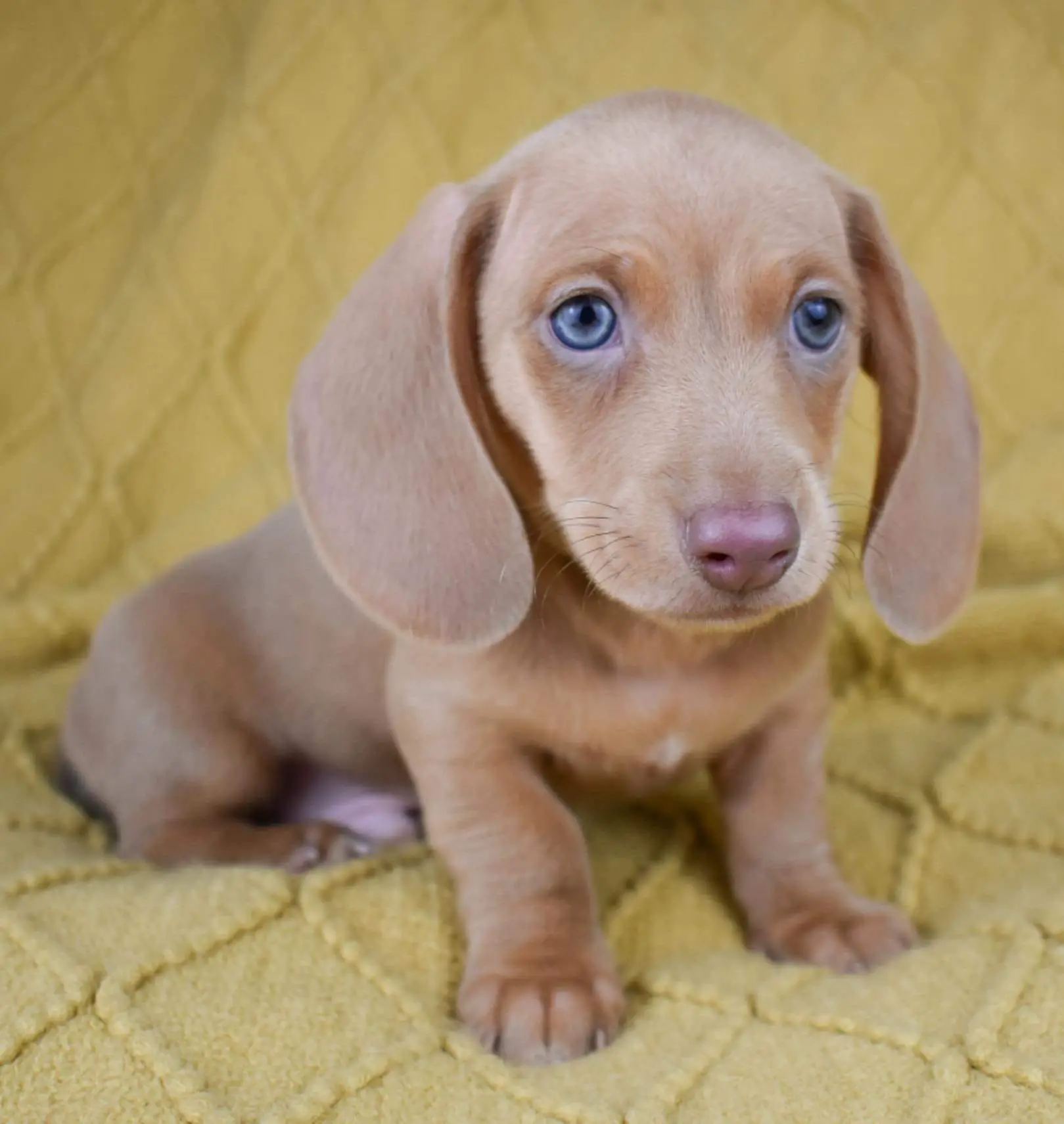An Isabella Dachshund is a unique variety of the breed, known for its distinctive coat color. Here’s a complete guide to the Isabella wiener.
The term “Isabella” refers to a dilute chocolate color, which is a pale, silvery fawn or light beige-gray color. This coloration is rare and is caused by a dilution gene affecting the black and chocolate colors in the dog’s coat.
Isabella dachshunds share the same physical characteristics as other dachshunds, such as their long bodies and short legs, but their unusual coat color sets them apart.
This color can be found in both the smooth and long-haired varieties of the breed. Like all dachshunds, they are known for their playful, curious, and sometimes stubborn temperament.
Main Image from Kaibab Dachshunds
What Colors Of Isabella Dachshund Are There?
The Isabella color is quite specific, characterized by a diluted chocolate color, which appears as a pale, silvery fawn or light beige-gray.
Within the Isabella color, there can be some variations, particularly when it comes to patterns and markings. Some of the common variations you might see in include:
Solid Isabella
This is the most straightforward expression of the Isabella color, where the dog’s entire coat is a uniform pale, silvery fawn or light beige-gray.
Isabella and Tan
Similar to the classic black and tan Dachshund, an Isabella and tan Dachshund will have the pale beige-gray color with tan markings, usually above the eyes, on the paws, and under the tail.
Isabella Dapple (or Merle)
In this variation, the dog has a pattern of dark and light patches. The dapple pattern can vary significantly, with some dogs having large areas of lighter color and others having a more mottled appearance.
Isabella Brindle
Brindle Isabella Dachshunds have a tiger-stripe pattern overlaying the Isabella color. This pattern is less common and can range from subtle to very distinct.
Isabella Piebald
Piebald Isabellas have a combination of solid areas of color and areas of white. This pattern can vary widely in terms of how much white is present and its distribution.
It’s important to note that while the Isabella color is visually appealing, it is the result of a dilution gene and can be associated with certain health issues, such as Color Dilution Alopecia.
This condition can cause hair thinning or loss, and skin problems in some dogs. As with all dog breeds, responsible breeding practices are crucial to ensure the health and well-being of the dogs.
Isabella Dachshund Varieties
Isabella Dachshunds feature different varieties based on coat type and pattern. Here are the main varieties of Isabella Dachshunds.
Coat Types
Smooth Coat Isabella Dachshund
Has a short, smooth, and shiny coat. This is the most common coat type for Dachshunds.
Long-Haired Isabella Dachshund
Features a long, silky coat that may be slightly wavy. The long hair is particularly noticeable on the dog’s ears, neck, underside, legs, and tail.
Wire-Haired Isabella Dachshund
Less common in the Isabella color, this variety has a thick, wiry outer coat and a softer undercoat.
Pattern Variations
Solid Isabella
The entire coat is a uniform pale, silvery fawn or light beige-gray without any other markings.
Isabella and Tan
Features the Isabella base color with tan markings typically above the eyes, on the paws, and under the tail.
Isabella Dapple (or Merle)
Characterized by a mix of lighter and darker patches over the Isabella base color. The dapple pattern can be quite varied.
Isabella Brindle
Displays a brindle pattern (similar to tiger stripes) over the Isabella base color.
Isabella Piebald
Has a combination of the Isabella color with significant patches of white.
Regardless of the variety, all Isabella Dachshunds share the characteristic traits of the Dachshund breed, including their playful and curious nature, long bodies, and short legs.
It’s important to remember that while coat color and pattern can be appealing, health and temperament are key factors to consider when choosing any dog.
What Is The Difference Between Dapple and Piebald Dachshunds?
Isabella, Dapple, and Piebald are terms that describe different coat colors and patterns in Dachshunds. Each has distinct characteristics:
Isabella Dachshunds
The term “Isabella” specifically refers to the color of the Dachshund’s coat. Isabella Dachshunds have a unique dilute chocolate color, which is a pale, silvery fawn or light beige-gray.
This coloration is caused by a dilution gene that affects the black and chocolate pigments in the dog’s coat.
Typically, Isabella Dachshunds have a solid color without any distinct patterns. However, they can also have secondary patterns like dapple, brindle, or piebald.
Dapple Dachshunds
“Dapple” refers to a pattern of lighter areas mixed with darker areas of the base coat color. It’s similar to the merle pattern seen in other dog breeds.
A Dapple Dachshund can have any base coat color, including black, chocolate, red, or Isabella. The dapple pattern creates a mottled or patchy appearance, with spots of lighter color scattered throughout the coat.
You can have an Isabella Dapple Dachshund, where the base Isabella color is overlaid with the dapple pattern.
Piebald Dachshunds
The piebald pattern is characterized by a white base coat with patches of another color, such as black, red, or Isabella.
Piebald Dachshunds have a distinct appearance due to the presence of large, irregular white areas on their coat.
An Isabella Piebald Dachshund would have the Isabella color combined with significant patches of white.
Isabella vs Standard Dachshund
The primary difference between an Isabella Dachshund and a Standard Dachshund lies in their coat color.
Isabella Dachshund
Coat Color
The most distinctive feature of an Isabella Dachshund is its coat color. The Isabella color is a diluted chocolate, resulting in a pale, silvery fawn or light beige-gray hue.
This unique color is due to a dilution gene that affects the black and chocolate pigments in the dog’s coat.
Other Characteristics
Apart from the coat color, Isabella Dachshunds share the same characteristics as other Dachshunds. This includes their physical build, temperament, and health considerations.
Standard Dachshund
Coat Color
Standard Dachshunds can come in a variety of colors including black, chocolate, red, cream, and various patterns like dapple, brindle, and piebald.
The term “standard” here refers to the size and not the color. Standard Dachshunds are larger than Miniature Dachshunds.
Size
Standard Dachshunds are typically about 8 to 9 inches tall at the shoulder and weigh anywhere from 16 to 32 pounds.
Isabella vs Dapple Dachshund
Comparing Isabella and Dapple Dachshunds involves distinguishing between a specific coat color and a coat pattern.
“Isabella” describes a specific coat color (a diluted chocolate), while “Dapple” describes a coat pattern characterized by mottled patches.
These terms can coexist, as in the case of an Isabella Dapple Dachshund, which would have the pale, silvery fawn coloration of an Isabella with the patchy pattern of a Dapple.
Isabella Dachshund
Coat Color
Isabella Dachshunds are characterized by their unique coat color. This color is a diluted form of chocolate, resulting in a pale, silvery fawn or light beige-gray hue.
The Isabella color is a result of a dilution gene affecting the black and chocolate pigments in the coat.
Pattern
Typically, Isabella Dachshunds have a solid color, but they can also have patterns like dapple, brindle, or piebald in combination with their Isabella color.
Dapple Dachshund
Coat Pattern
Dapple refers to a pattern, not a color. Dapple Dachshunds have a mottled or patchy coat pattern, with lighter areas mixed with darker areas of the base coat color. This pattern is similar to the merle pattern in other dog breeds.
Base Color Variations
The base coat color of a Dapple Dachshund can be any standard Dachshund color, including black, chocolate, red, or even Isabella.
So, you can have an Isabella Dapple Dachshund, where the base Isabella color is interspersed with lighter and darker patches.
Dapple Dachshund Breeders & Puppies
When looking to buy an Isabella Dachshund puppy, it’s important to be well-informed and cautious, as this is a unique and somewhat rare color variant.
Buying an Isabella Dachshund requires careful consideration and research. It’s essential to ensure that you are supporting ethical breeding practices and preparing adequately for a new family member.
Remember, the health and well-being of your future pet should always be the top priority.
Research the Breed
Understand the Breed
Familiarize yourself with Dachshunds’ general temperament, health issues, and care needs. Isabella Dachshunds have the same characteristics as other Dachshunds, aside from their coat color.
Color-Specific Considerations
Be aware that the Isabella color is a result of a dilution gene, which can sometimes be associated with health issues like Color Dilution Alopecia, leading to hair thinning or skin problems.
Find Reputable Breeders
Prioritize Reputability
Look for breeders who specialize in Dachshunds and have experience with the Isabella color. A reputable breeder will prioritize the health and temperament of their puppies.
Health Testing
Ensure the breeder conducts genetic and health testing on the parent dogs. This helps reduce the likelihood of inherited health issues.
Ask Questions
Enquire about the puppies’ upbringing, socialization, and veterinary care.
Visit the Breeder
If possible, visit the breeder to see the conditions in which the puppies are raised.
Understand the Costs
Isabella Dachshunds might be priced higher due to their rarity. However, beware of excessively high prices.
Consider the long-term costs of owning a dog, including veterinary care, food, grooming, and emergency expenses.
Meet the Puppy
Look for a puppy with a good temperament, clear eyes, and a healthy coat. Avoid puppies that appear overly shy or aggressive.
Request documentation of vaccinations and any medical treatments the puppy has received.
Prepare for Homecoming
Ensure your home is safe and welcoming for a puppy. Dachshunds, being small and curious, can get into small spaces and may need protection from hazards.
Be prepared for house training and basic obedience training.
Post-Purchase Support
A good breeder will offer support and advice even after you take the puppy home.
Schedule a veterinary check-up shortly after bringing your puppy home.
Ethical Considerations
Choose a puppy based on health and compatibility, not just color.
Consider checking rescue centers, as occasionally Dachshunds of various colors, including rare ones, may be available for adoption.

